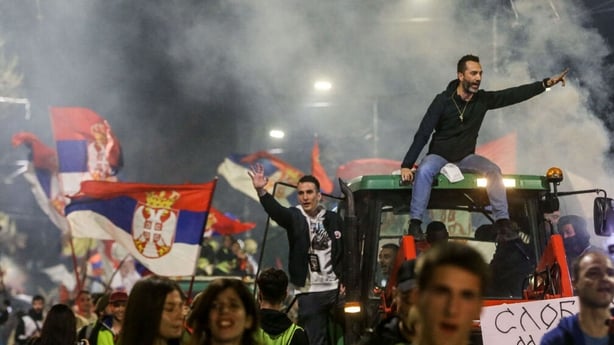The death toll in the collapse of a train station roof in Serbia - which has triggered massive anti-government protests - has risen to 16, after a teenager died of his injuries.
The boy, who was being treated at a military hospital in the capital, Belgrade, thus became the latest victim of the disaster in Novi Sad last November.
"Despite all measures taken and the utmost dedication of our staff, the patient (born in 2006) succumbed to complex injuries and related complications," the hospital said on its website.
"We extend our deepest condolences to the family."
Soon after news of his death broke, a black flag was raised on the building of the Novi Sad School of Economics he attended, and mourners laid flowers and lit candles.

"You will forever be a part of our stories, our memories, and our hearts," read one banner left outside the school by pupils.
The concrete roof at the Novi Sad station came crashing down on 1 November, killing 14 people on the spot. The victims were aged between six and 74.
Three others were injured, one of whom died two weeks later.
Public outrage over the tragedy sparked nationwide protests.
Many critics blamed the deaths on corruption and inadequate oversight of construction projects, especially as restoration work at the train station had been completed shortly before the accident.
Protesters are demanding that those responsible be held accountable, that arrested demonstrators be released, and that the system be made less corrupt.
Massive protests
Last Saturday, between 100,000 and 300,000 people are estimated to have taken part in a mass rally in Belgrade - the largest in Serbian history.
The largely peaceful demonstration was disrupted after an unknown noise caused a brief panic in some areas.
Some protesters and members of the political opposition allege the authorities used an acoustic cannon - a military device used to disperse crowds - a charge the government has denied.
The incident further heightened tensions in the Balkan country and triggered a series of reactions and calls for an investigation into the events.
The Council of Europe right body said it was "very concerned about the escalation of tensions in the country" and called for a thorough investigation of the incident.
Serbian caretaker Prime Minister Milos Vucevic said today that he had sent a letter to his Russian counterpart, Mikhail Mishustin, requesting assistance in the investigation, as well as an earlier letter to US Vice President J.D. Vance.
'Grateful' to Russia
Tens of thousands of people have taken to the streets of Novi Sad, Kragujevac, and Nis in recent months.
Protests and commemorative gatherings have also been held in hundreds of towns across the country.
They represent the biggest challenge so far to the 12-year rule of populist President Aleksandar Vucic.
He has responded by alternating between calls for dialogue and claims that the demonstrators are backed by foreign powers.
Serbia's Deputy Prime Minister Aleksandar Vulin picked up that narrative comments today.
Serbia's authorities were "grateful to the Russian special services for the information that helps in the fight against the 'colour revolution'", he told Russia's RIA state news agency.
The protests have led to the resignation of several high-ranking officials in Serbia, including the prime minister, who is currently serving a one-month caretaker mandate.
More than a dozen people have been charged in connection with the tragedy, including former Transport Minister Goran Vesic, who resigned days after the incident.

